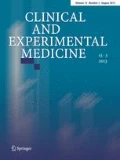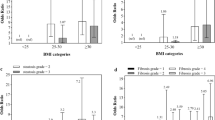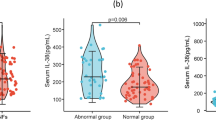Abstract
Morbid obesity has been shown to increase the risk to develop hepatic steatosis, also referred to as non-alcoholic fatty liver disease (NAFLD). Emerging evidence suggests that the severity of NAFLD may associate with increased serum levels of inflammatory markers as well as decreased concentration of mediators with anti-inflammatory actions, such as tumor necrosis factor alpha (TNF-α) and interleukin (IL) 10, respectively. We thus examined the serum levels of TNF-α and IL-10 in 102 morbidly obese women and men (body mass index > 40 kg/m2), exhibiting different grades of NAFLD. Blood glucose, glycated hemoglobin, insulin, the homeostatic model assessment of insulin resistance (HOMA-IR), total cholesterol, triglycerides, high- and low-density lipoproteins, parameters of liver function, TNF-α, and IL-10 were measured in each subject. The stage of NAFLD was estimated by abdominal ultrasound imaging. In comparison with morbidly obese subjects without steatosis, morbidly obese patients with NAFLD showed increased age (39.23 ± 9.80 years), HOMA-IR (6.74 ± 1.62), total cholesterol (219.7 ± 9.58 mg/dl), aspartate aminotransferase (36.25 ± 3.24 UI/l), gamma-glutamyl transpeptidase (37.12 ± 3.41 UI/l), and TNF-α (37.41 ± 1.72 pg/ml) as well as decreased serum levels of IL-10 (61.05 ± 2.43 pg/ml). Interestingly, the systemic levels of TNF-α increased, while IL-10 decreased in accordance with the severity of NAFLD, which supports a role for systemic inflammatory mediators in promoting steatosis progression. Further clinical prospective studies need to be addressed to elucidate the role of TNF-α and IL-10 in the development of NAFLD while also establishing their clinical utility in the assessment of morbidly obese patients at higher risk to develop severe steatosis.

Similar content being viewed by others
References
Clinical guidelines on the identification, evaluation, and treatment of overweight and obesity in adults: executive summary. Expert Panel on the Identification, Evaluation, and Treatment of Overweight in Adults. Am J Clin Nutr. 1998;68(4):899–917.
Popkin BM. Does global obesity represent a global public health challenge? Am J Clin Nutr. 2011;93(2):232–3. doi:10.3945/ajcn.110.008458.
Gutiérrez JP R-DJ, Shamah-Levy T, Villalpando-Hernández S, Franco A, Cuevas-Nasu L, Romero-Martínez M H-ÁM. Encuesta Nacional de Salud y Nutrición 2012. Resultados Nacionales. 2012.
Barquera S, Campos-Nonato I, Hernandez-Barrera L, Pedroza A, Rivera-Dommarco JA. Prevalence of obesity in Mexican adults 2000–2012. Salud Publica Mex. 2013;55(Suppl 2):S151–60.
Efthymiou V, Hyphantis T, Karaivazoglou K, Gourzis P, Alexandrides TK, Kalfarentzos F, et al. The effect of bariatric surgery on patient HRQOL and sexual health during a 1-year postoperative period. Obes Surg. 2014;. doi:10.1007/s11695-014-1384-x.
Kitahara CM, Flint AJ, Berrington de Gonzalez A, Bernstein L, Brotzman M, MacInnis RJ, et al. Association between class III obesity (BMI of 40–59 kg/m2) and mortality: a pooled analysis of 20 prospective studies. PLoS Med. 2014;11(7):e1001673. doi:10.1371/journal.pmed.1001673.
Rodriguez-Gallego E, Guirro M, Riera-Borrull M, Hernandez-Aguilera A, Marine-Casado R, Fernandez-Arroyo S, et al. Mapping of the circulating metabolome reveals alpha-ketoglutarate as a predictor of morbid obesity-associated non-alcoholic fatty liver disease. Int J Obes (Lond). 2014;. doi:10.1038/ijo.2014.53.
Bluher M. The distinction of metabolically ‘healthy’ from ‘unhealthy’ obese individuals. Curr Opin Lipidol. 2010;21(1):38–43. doi:10.1097/MOL.0b013e3283346ccc.
Neuschwander-Tetri BA, Caldwell SH. Nonalcoholic steatohepatitis: summary of an AASLD single topic conference. Hepatology. 2003;37(5):1202–19. doi:10.1053/jhep.2003.50193.
Paredes AH, Torres DM, Harrison SA. Nonalcoholic fatty liver disease. Clin Liver Dis. 2012;16(2):397–419. doi:10.1016/j.cld.2012.03.005.
Gholam PM, Flancbaum L, Machan JT, Charney DA, Kotler DP. Nonalcoholic fatty liver disease in severely obese subjects. Am J Gastroenterol. 2007;102(2):399–408. doi:10.1111/j.1572-0241.2006.01041.x.
Dixon JB, Bhathal PS, O’Brien PE. Nonalcoholic fatty liver disease: predictors of nonalcoholic steatohepatitis and liver fibrosis in the severely obese. Gastroenterology. 2001;121(1):91–100.
Tran A, Gual P. Non-alcoholic steatohepatitis in morbidly obese patients. Clin Res Hepatol Gastroenterol. 2013;37(1):17–29. doi:10.1016/j.clinre.2012.07.005.
Adams LA, Sanderson S, Lindor KD, Angulo P. The histological course of nonalcoholic fatty liver disease: a longitudinal study of 103 patients with sequential liver biopsies. J Hepatol. 2005;42(1):132–8. doi:10.1016/j.jhep.2004.09.012.
Suarez-Alvarez K, Solis-Lozano L, Leon-Cabrera S, Gonzalez-Chavez A, Gomez-Hernandez G, Quinones-Alvarez MS, et al. Serum IL-12 is increased in Mexican obese subjects and associated with low-grade inflammation and obesity-related parameters. Mediators Inflamm. 2013;2013:967067. doi:10.1155/2013/967067.
Leon-Cabrera S, Solis-Lozano L, Suarez-Alvarez K, Gonzalez-Chavez A, Bejar YL, Robles-Diaz G, et al. Hyperleptinemia is associated with parameters of low-grade systemic inflammation and metabolic dysfunction in obese human beings. Front Integr Neurosci. 2013;7:62. doi:10.3389/fnint.2013.00062.
Zahran WE, Salah El-Dien KA, Kamel PG, El-Sawaby AS. Efficacy of tumor necrosis factor and interleukin-10 analysis in the follow-up of nonalcoholic fatty liver disease progression. Indian J Clin Biochem. 2013;28(2):141–6. doi:10.1007/s12291-012-0236-5.
Rumack CWS, Charboneau W. Diagnostic ultrasound. 2nd ed. St Louis: Mosby; 1998.
Grundy SM, Brewer HB Jr, Cleeman JI, Smith SC Jr, Lenfant C. Definition of metabolic syndrome: report of the National Heart, Lung, and Blood Institute/American Heart Association conference on scientific issues related to definition. Circulation. 2004;109(3):433–8. doi:10.1161/01.CIR.0000111245.75752.C6.
Rosas-Guzmán J G-CA, Aschner P, Bastarrachea P. Consenso Latinoamericano de la Asociación Latinoamericana de Diabetes (ALAD) Epidemiología, Diagnóstico, Control, Prevención y Tratamiento del Síndrome Metabólico en Adultos. Consensos ALAD. 2010.
Luo W, Guo Z, Wu M, Hao C, Zhou Z, Yao X. Index of central obesity as a parameter to replace waist circumference for the definition of metabolic syndrome in predicting cardiovascular disease. J Cardiovasc Med (Hagerstown). 2014;15(10):738–44. doi:10.2459/JCM.0000000000000039.
Tiehuis AM, van der Graaf Y, Mali WP, Vincken K, Muller M, Geerlings MI. Metabolic syndrome, prediabetes, and brain abnormalities on MRI in patients with manifest arterial disease: the SMART-MR study. Diabetes Care. 2014;37(9):2515–21. doi:10.2337/dc14-0154.
Segula D. Complications of obesity in adults: a short review of the literature. Malawi Med J. 2014;26(1):20–4.
Flegal KM, Carroll MD, Ogden CL, Johnson CL. Prevalence and trends in obesity among US adults, 1999–2000. JAMA. 2002;288(14):1723–7.
Dietz WH, Robinson TN. Clinical practice. Overweight children and adolescents. N Engl J Med. 2005;352(20):2100–9. doi:10.1056/NEJMcp043052.
Chitturi S, Farrell GC. Etiopathogenesis of nonalcoholic steatohepatitis. Semin Liver Dis. 2001;21(1):27–41.
McFarlin BK, Johnson CA, Moreno JP, Foreyt JP. Mexican American children have differential elevation of metabolic biomarkers proportional to obesity status. J Pediatr Gastroenterol Nutr. 2013;57(6):718–21. doi:10.1097/MPG.0b013e3182a6993d.
Invitti C, Maffeis C, Gilardini L, Pontiggia B, Mazzilli G, Girola A, et al. Metabolic syndrome in obese Caucasian children: prevalence using WHO-derived criteria and association with nontraditional cardiovascular risk factors. Int J Obes (Lond). 2006;30(4):627–33. doi:10.1038/sj.ijo.0803151.
Rizzo AC, Goldberg TB, Silva CC, Kurokawa CS, Nunes HR, Corrente JE. Metabolic syndrome risk factors in overweight, obese, and extremely obese Brazilian adolescents. Nutr J. 2013;12:19. doi:10.1186/1475-2891-12-19.
Barbarroja N, Lopez-Pedrera R, Mayas MD, Garcia-Fuentes E, Garrido-Sanchez L, Macias-Gonzalez M, et al. The obese healthy paradox: is inflammation the answer? Biochem J. 2010;430(1):141–9. doi:10.1042/BJ20100285.
Goday A, Benaiges D, Parri A, Ramon JM, Flores-Le Roux JA, Pedro Botet J. Can bariatric surgery improve cardiovascular risk factors in the metabolically healthy but morbidly obese patient? Surg Obes Relat Dis. 2014;. doi:10.1016/j.soard.2014.04.022.
Jimenez A, Perea V, Corcelles R, Moize V, Lacy A, Vidal J. Metabolic effects of bariatric surgery in insulin-sensitive morbidly obese subjects. Obes Surg. 2013;23(4):494–500. doi:10.1007/s11695-012-0817-7.
Bluher M. Are there still healthy obese patients? Curr Opin Endocrinol Diabetes Obes. 2012;19(5):341–6. doi:10.1097/MED.0b013e328357f0a3.
Angulo P. GI epidemiology: nonalcoholic fatty liver disease. Aliment Pharmacol Ther. 2007;25(8):883–9. doi:10.1111/j.1365-2036.2007.03246.x.
Sims EA. Are there persons who are obese, but metabolically healthy? Metabolism. 2001;50(12):1499–504. doi:10.1053/meta.2001.27213.
de la Cruz-Munoz N, Messiah SE, Arheart KL, Lopez-Mitnik G, Lipshultz SE, Livingstone A. Bariatric surgery significantly decreases the prevalence of type 2 diabetes mellitus and pre-diabetes among morbidly obese multiethnic adults: long-term results. J Am Coll Surg. 2011;212(4):505–11; discussion 12–3. doi:10.1016/j.jamcollsurg.2010.12.015.
Koh KK, Han SH, Quon MJ. Inflammatory markers and the metabolic syndrome: insights from therapeutic interventions. J Am Coll Cardiol. 2005;46(11):1978–85. doi:10.1016/j.jacc.2005.06.082.
Hayashino Y, Jackson JL, Hirata T, Fukumori N, Nakamura F, Fukuhara S, et al. Effects of exercise on C-reactive protein, inflammatory cytokine and adipokine in patients with type 2 diabetes: a meta-analysis of randomized controlled trials. Metabolism. 2014;63(3):431–40. doi:10.1016/j.metabol.2013.08.018.
Esser N, Legrand-Poels S, Piette J, Scheen AJ, Paquot N. Inflammation as a link between obesity, metabolic syndrome and type 2 diabetes. Diabetes Res Clin Pract. 2014;105(2):141–50. doi:10.1016/j.diabres.2014.04.006.
DeMarco VG, Johnson MS, Whaley-Connell AT, Sowers JR. Cytokine abnormalities in the etiology of the cardiometabolic syndrome. Curr Hypertens Rep. 2010;12(2):93–8. doi:10.1007/s11906-010-0095-5.
Gotoh K, Inoue M, Shiraishi K, Masaki T, Chiba S, Mitsutomi K, et al. Spleen-derived interleukin-10 downregulates the severity of high-fat diet-induced non-alcoholic fatty pancreas disease. PLoS ONE. 2012;7(12):e53154. doi:10.1371/journal.pone.0053154.
Yekollu SK, Thomas R, O’Sullivan B. Targeting curcusomes to inflammatory dendritic cells inhibits NF-kappaB and improves insulin resistance in obese mice. Diabetes. 2011;60(11):2928–38. doi:10.2337/db11-0275.
Chuang CC, McIntosh MK. Potential mechanisms by which polyphenol-rich grapes prevent obesity-mediated inflammation and metabolic diseases. Annu Rev Nutr. 2011;31:155–76. doi:10.1146/annurev-nutr-072610-145149.
Liu Y, Dang H, Li D, Pang W, Hammock BD, Zhu Y. Inhibition of soluble epoxide hydrolase attenuates high-fat-diet-induced hepatic steatosis by reduced systemic inflammatory status in mice. PLoS ONE. 2012;7(6):e39165. doi:10.1371/journal.pone.0039165.
Fierbinteanu-Braticevici C, Baicus C, Tribus L, Papacocea R. Predictive factors for nonalcoholic steatohepatitis (NASH) in patients with nonalcoholic fatty liver disease (NAFLD). J Gastrointestin Liver Dis. 2011;20(2):153–9.
Pappo I, Bercovier H, Berry E, Gallilly R, Feigin E, Freund HR. Antitumor necrosis factor antibodies reduce hepatic steatosis during total parenteral nutrition and bowel rest in the rat. J Parenter Enteral Nutr. 1995;19(1):80–2.
Seki S, Kitada T, Sakaguchi H. Clinicopathological significance of oxidative cellular damage in non-alcoholic fatty liver diseases. Hepatol Res. 2005;33(2):132–4. doi:10.1016/j.hepres.2005.09.020.
Higuchi H, Gores GJ. Mechanisms of liver injury: an overview. Curr Mol Med. 2003;3(6):483–90.
Jaeschke H, Gores GJ, Cederbaum AI, Hinson JA, Pessayre D, Lemasters JJ. Mechanisms of hepatotoxicity. Toxicol Sci. 2002;65(2):166–76.
Budick-Harmelin N, Dudas J, Demuth J, Madar Z, Ramadori G, Tirosh O. Triglycerides potentiate the inflammatory response in rat Kupffer cells. Antioxid Redox Signal. 2008;10(12):2009–22. doi:10.1089/ars.2007.1876.
Seth RK, Das S, Kumar A, Chanda A, Kadiiska MB, Michelotti G, et al. CYP2E1-dependent and leptin-mediated hepatic CD57 expression on CD8+ T cells aid progression of environment-linked nonalcoholic steatohepatitis. Toxicol Appl Pharmacol. 2014;274(1):42–54. doi:10.1016/j.taap.2013.10.029.
Horton JD, Goldstein JL, Brown MS. SREBPs: activators of the complete program of cholesterol and fatty acid synthesis in the liver. J Clin Invest. 2002;109(9):1125–31. doi:10.1172/JCI15593.
Roden M. Mechanisms of disease: hepatic steatosis in type 2 diabetes—pathogenesis and clinical relevance. Nat Clin Pract Endocrinol Metab. 2006;2(6):335–48. doi:10.1038/ncpendmet0190.
Saraiva M, O’Garra A. The regulation of IL-10 production by immune cells. Nat Rev Immunol. 2010;10(3):170–81. doi:10.1038/nri2711.
Rabelo F, Oliveira CP, Faintuch J, Mazo DF, Lima VM, Stefano JT, et al. Pro- and anti-inflammatory cytokines in steatosis and steatohepatitis. Obes Surg. 2010;20(7):906–12. doi:10.1007/s11695-010-0181-4.
Cintra DE, Pauli JR, Araujo EP, Moraes JC, de Souza CT, Milanski M, et al. Interleukin-10 is a protective factor against diet-induced insulin resistance in liver. J Hepatol. 2008;48(4):628–37. doi:10.1016/j.jhep.2007.12.017.
Zhou DS, Liang ZQ, Qin Q, Zhang MH, Li SL. Therapeutic efficacy and mechanisms of quercetin in a rat model of nonalcoholic fatty liver disease. Zhonghua Gan Zang Bing Za Zhi. 2013;21(2):134–7. doi:10.3760/cma.j.issn.1007-3418.2013.02.014.
den Boer MA, Voshol PJ, Schroder-van der Elst JP, Korsheninnikova E, Ouwens DM, Kuipers F, et al. Endogenous interleukin-10 protects against hepatic steatosis but does not improve insulin sensitivity during high-fat feeding in mice. Endocrinology. 2006;147(10):4553–8. doi:10.1210/en.2006-0417.
Wang Y, Li YY, Nie YQ, Zhou YJ, Cao CY, Xu L. Association between metabolic syndrome and the development of non-alcoholic fatty liver disease. Exp Ther Med. 2013;6(1):77–84. doi:10.3892/etm.2013.1090.
Shima T, Seki K, Umemura A, Ogawa R, Horimoto R, Oya H, et al. Influence of lifestyle-related diseases and age on the development and progression of non-alcoholic fatty liver disease. Hepatol Res. 2014;. doi:10.1111/hepr.12384.
Wang Z, Xu M, Peng J, Jiang L, Hu Z, Wang H, et al. Prevalence and associated metabolic factors of fatty liver disease in the elderly. Exp Gerontol. 2013;48(8):705–9. doi:10.1016/j.exger.2013.05.059.
Mocchegiani E, Costarelli L, Giacconi R, Malavolta M, Basso A, Piacenza F, et al. Vitamin E-gene interactions in aging and inflammatory age-related diseases: implications for treatment. A systematic review. Ageing Res Rev. 2014;14:81–101. doi:10.1016/j.arr.2014.01.001.
Arutyunyan TV, Korystova AF, Kublik LN, Levitman M, Shaposhnikova VV, Korystov YN. Effects of taxifolin on the activity of angiotensin-converting enzyme and reactive oxygen and nitrogen species in the aorta of aging rats and rats treated with the nitric oxide synthase inhibitor and dexamethasone. Age (Dordr). 2013;35(6):2089–97. doi:10.1007/s11357-012-9497-4.
Kozina LS, Borzova IV, Arutiunov VA, Ryzhak GA. The role of oxidative stress in skin aging. Adv Gerontol. 2012;25(2):217–22.
Acknowledgments
This work was supported by grant no. CB-2009-01-129316 from Consejo Nacional de Ciencia y Tecnologia (CONACYT) to G. Escobedo and is part of the requirements to obtain the Specialty in Internal Medicine of G. Paredes-Turrubiarte in the Programa de Especializaciones Médicas de la Universidad Nacional Autónoma de México.
Conflict of interest
The authors declare that they have no conflict of interest.
Ethical standard
All procedures performed in studies involving human participants were in accordance with the ethical standards of the institutional research committee and with the 1964 Helsinki declaration and its latter amendments or comparable ethical standards.
Informed consent
Informed consent was obtained from all individuals participants included in the study.
Author information
Authors and Affiliations
Corresponding authors
Rights and permissions
About this article
Cite this article
Paredes-Turrubiarte, G., González-Chávez, A., Pérez-Tamayo, R. et al. Severity of non-alcoholic fatty liver disease is associated with high systemic levels of tumor necrosis factor alpha and low serum interleukin 10 in morbidly obese patients. Clin Exp Med 16, 193–202 (2016). https://doi.org/10.1007/s10238-015-0347-4
Received:
Accepted:
Published:
Issue Date:
DOI: https://doi.org/10.1007/s10238-015-0347-4




